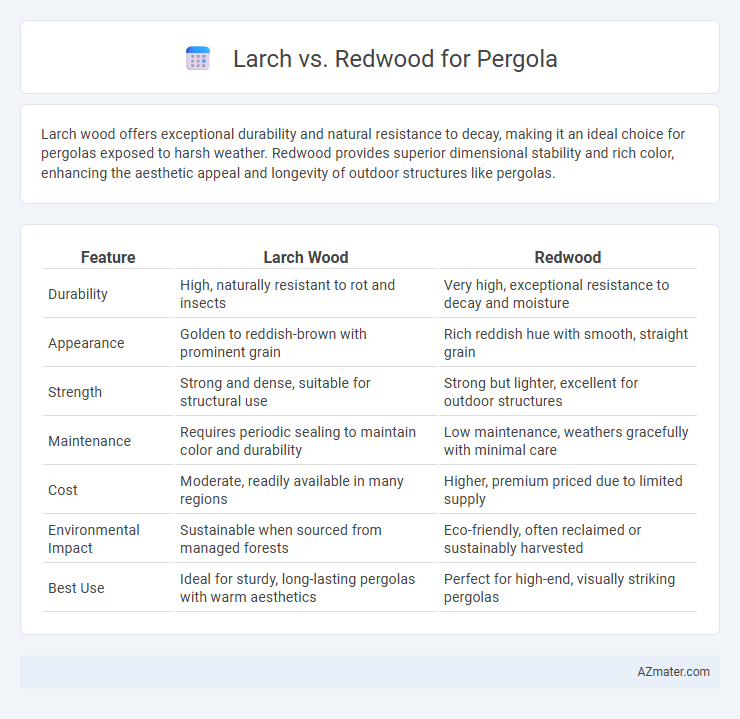Larch wood offers exceptional durability and natural resistance to decay, making it an ideal choice for pergolas exposed to harsh weather. Redwood provides superior dimensional stability and rich color, enhancing the aesthetic appeal and longevity of outdoor structures like pergolas.
Table of Comparison
| Feature | Larch Wood | Redwood |
|---|---|---|
| Durability | High, naturally resistant to rot and insects | Very high, exceptional resistance to decay and moisture |
| Appearance | Golden to reddish-brown with prominent grain | Rich reddish hue with smooth, straight grain |
| Strength | Strong and dense, suitable for structural use | Strong but lighter, excellent for outdoor structures |
| Maintenance | Requires periodic sealing to maintain color and durability | Low maintenance, weathers gracefully with minimal care |
| Cost | Moderate, readily available in many regions | Higher, premium priced due to limited supply |
| Environmental Impact | Sustainable when sourced from managed forests | Eco-friendly, often reclaimed or sustainably harvested |
| Best Use | Ideal for sturdy, long-lasting pergolas with warm aesthetics | Perfect for high-end, visually striking pergolas |
Introduction to Larch and Redwood for Pergolas
Larch and Redwood are popular timber choices for pergolas due to their durability and natural resistance to decay. Larch offers a dense, strong wood with a warm reddish-brown hue that weathers to a silvery gray over time, making it ideal for outdoor structures exposed to the elements. Redwood provides a lightweight yet sturdy option with inherent resistance to insects and moisture, showcasing rich red tones that enhance the aesthetic appeal of pergolas.
Botanical Overview: Larch vs Redwood
Larch (Larix spp.) is a deciduous conifer known for its needle-like leaves that turn golden in autumn before shedding, making it unique among conifers used in pergolas. Redwood (Sequoia sempervirens), an evergreen conifer, features rich reddish-brown wood renowned for its natural resistance to decay and insects, ideal for long-lasting outdoor structures. Both species offer durable timber, but Larch's seasonal foliage provides visual interest, whereas Redwood's consistent greenery ensures year-round aesthetic appeal for pergolas.
Appearance and Aesthetic Differences
Larch wood features a warm, golden-yellow hue with pronounced grain patterns that develop a natural patina over time, offering a rustic and textured aesthetic for pergolas. Redwood exhibits rich reddish-brown tones with smooth, fine grain and natural knots, providing a luxurious and classic appearance that enhances outdoor structures. The choice between larch and redwood influences pergola ambiance by balancing rugged charm against refined elegance.
Durability and Lifespan Comparison
Larch wood offers high durability with natural resin content that resists rot and insect damage, making it suitable for outdoor structures like pergolas with an average lifespan of 20 to 30 years. Redwood is renowned for its exceptional resistance to decay and moisture, providing a lifespan that often exceeds 30 years, thanks to its high tannin levels and dense grain. Both woods perform well in outdoor environments, but redwood generally outlasts larch due to its superior natural preservative qualities.
Weather Resistance and Maintenance Needs
Larch wood offers excellent weather resistance due to its natural oils and dense grain, making it highly durable against moisture, rot, and insects, which reduces maintenance needs significantly for pergolas. Redwood also exhibits outstanding weather resistance attributed to its natural tannins and stability, needing minimal protective treatment while resisting warping and decay over time. Both woods require periodic cleaning and occasional sealing, but larch demands slightly more upkeep in harsher climates compared to the more resilient redwood.
Cost Analysis: Larch vs Redwood
Larch offers a more cost-effective option for pergolas, with prices typically 30-50% lower than premium Redwood, making it ideal for budget-conscious projects. Redwood's higher upfront investment is balanced by its superior natural resistance to decay and insects, potentially reducing long-term maintenance costs. Considering material price, durability, and maintenance expenses provides a comprehensive cost analysis for selecting between Larch and Redwood pergolas.
Sustainability and Environmental Impact
Larch offers high sustainability due to its rapid growth and natural resistance to decay, reducing the need for chemical treatments and frequent replacements in pergola construction. Redwood, while slower growing, is prized for its durability and carbon sequestration abilities, making it an environmentally responsible choice when sourced from certified sustainable forests. Both woods provide eco-friendly options, but Larch's faster renewability often results in a lower overall environmental footprint for pergolas.
Ease of Sourcing and Availability
Larch wood is widely available in Europe and northern Asia, making it easier to source locally with consistent supply chains, while redwood, predominantly harvested in the western United States, may face restrictions and higher shipping costs internationally. Larch is often stocked by major lumber suppliers due to its affordability and abundance, whereas redwood's limited regional availability can lead to longer lead times. Choosing larch ensures more reliable access for pergola projects, especially outside of redwood's native growing regions.
Workability and Installation Differences
Larch wood offers excellent workability with its moderate hardness, making it easy to cut, nail, and shape for precise pergola construction, while its natural resin content provides good resistance to decay without heavy treatment. Redwood is softer and lighter, allowing for faster installation and effortless sanding, although it demands careful handling to avoid dents and scratches during assembly. Both woods perform well outdoors, but larch's higher density results in a sturdier structure, whereas redwood's uniform grain enhances aesthetic finish and ease of staining.
Best Choice: Larch or Redwood for Your Pergola?
Larch offers exceptional durability and natural resistance to rot, making it a cost-effective choice for pergolas that withstand outdoor elements. Redwood is prized for its rich color, fine grain, and superior resistance to decay and insects, providing a longer-lasting and more aesthetically pleasing structure. Choosing between larch and redwood depends on your budget and desired appearance, with redwood being the premium option for longevity and visual appeal.

Infographic: Larch vs Redwood for Pergola
 azmater.com
azmater.com